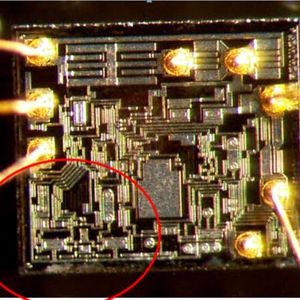 Attack MCU PIC16CR84 Code
Attack MCU PIC16CR84 Code
Attack MCU PIC16CR84 memory secured system and extract code from microcontroller pic16cr84 flash and eeprom memory, copy the readout firmware to new MCU which will provide the same functions as originals;

A variety of frequency ranges and packaging options are available. Depending on application and production requirements the proper device option can be selected using the information in this section. When placing orders, please use the “PIC16F8X Product Identification System” at the back of this data sheet to specify the correct part number.
There are four device “types” as indicated in the device number.
1. F, as in PIC16F84. These devices have Flash program memory and operate over the standard voltage range after Attack MCU.
2. LF, as in PIC16LF84. These devices have Flash program memory and operate over an extended voltage range.
3. CR, as in PIC16CR83. These devices have ROM program memory and operate over the standard voltage range.
4. LCR, as in PIC16LCR84. These devices have ROM program memory and operate over an extended voltage range if Attack attiny2313 MCU memory.
When discussing memory maps and other architectural features, the use of F and CR also implies the LF and LCR versions.
2.1 Flash Devices
These devices are offered in the lower cost plastic package, even though the device can be erased and reprogrammed. This allows the same device to be used for prototype development and pilot programs as well as production.
A further advantage of the electrically-erasable Flash version is that it can be erased and reprogrammed in-circuit, or by device programmers, such as Microchip’s PICSTART® Plus or PRO MATE® II programmers when copy avr atmega165a memory file.
2.2 Quick-Turnaround-Production (QTP) Devices
Microchip offers a QTP Programming Service for factory production orders. This service is made available for users who choose not to program a medium to high quantity of units and whose code patterns have stabilized.
The devices have all Flash locations and configuration options already programmed by the factory. Certain code and prototype verification procedures do apply before production shipments are available.
2.3 Serialized Quick-Turnaround-Production (SQTP SM ) Devices
Microchip offers the unique programming service where a few user-defined locations in each device are programmed with different serial numbers. The serial numbers may be random, pseudo-random or sequential.
Serial programming allows each device to have a unique number which can serve as an entry-code, password or ID number.
Some of Microchip’s devices have a corresponding device where the program memory is a ROM. These devices give a cost savings over Microchip’s traditional user programmed devices (EPROM, EEPROM) when Attack MCU. ROM devices (PIC16CR8X) do not allow serialization information in the program memory space.
The user may program this information into the Data EEPROM.
The high performance of the PIC16CXX family can be attributed to a number of architectural features commonly found in RISC microprocessors. To begin with, the PIC16CXX uses a Harvard architecture. This architecture has the program and data accessed from separate memories. So the device has a program memory bus and a data memory bus.
This improves bandwidth over traditional von Neumann architecture where program and data are fetched from the same memory (accesses over the same bus) after Attack MCU. Separating program and data memory further allows instructions to be sized differently than the 8-bit wide data word. PIC16CXX opcodes are 14-bits wide, enabling single word instructions.
The full 14-bit wide program memory bus fetches a 14-bit instruction in a single cycle. A two-stage pipeline overlaps fetch and execution of instructions (Example 3-1). Consequently, all instructions execute in a single cycle except for program branches when copy pic12c509 MCU program.
The PIC16F83 and PIC16CR83 address 512 x 14 of program memory, and the PIC16F84 and PIC16CR84 address 1K x 14 program memory. All program memory is internal.